| Release List | Reviews | Price Search | Shop | Newsletter | Forum | DVD Giveaways | Blu-Ray/ HD DVD | Advertise |
| Reviews & Columns |
|
Reviews DVD TV on DVD Blu-ray International DVDs Theatrical Reviews by Studio Video Games Features Collector Series DVDs Easter Egg Database Interviews DVD Talk TV DVD Talk Radio Feature Articles Columns Anime Talk DVD Savant HD Talk Horror DVDs Silent DVD
|
DVD Talk Forum |
|
|
| Resources |
|
DVD Price Search Customer Service #'s RCE Info Links |
|
Columns
|
 |
Glamour Girls
|
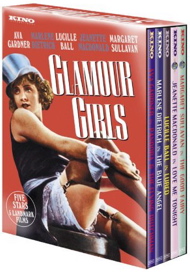
|
Kino The Blue Angel, Love Me Tonight, The Good Fairy, Lured, Pandora and the Flying Dutchman Starring Marlene Dietrich, Jeanette Macdonald, Margaret Sullavan, Lucille Ball, Ava Gardner 1:37 flat full frame Street Date November 21, 2006 49.95 the boxed set Reviewed by Glenn Erickson |
Kino's Glamour Girls set pulls together five rather disparate films, all featuring strong female leads. The roll call includes one Rouben Mamoulian masterpiece, a delightful romantic comedy from William Wyler, a so-so Douglas Sirk murder thriller with an interesting cast, a pretentious but enjoyable fantasy from Albert Lewin, and one all-time German classic by Josef von Sternberg. Or, more accurately, the English-language version of that all-time German classic. The films may be a mix but they're all winners.
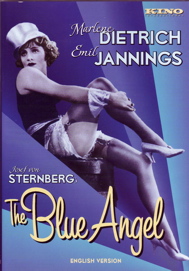
The Blue Angel
1930 / min. / Der Blaue Engel (German-language version)
Starring Emil Jannings, Marlene Dietrich, Kurt Gerron, Rosa Valetti, Hans Albers
Cinematography Günther Rittau
Art Direction Otto Hunte
Film Editor Walter Klee, S.K. Winston
Written by Carl Zuckmayer, Karl Vollmöller, Heinrich Mann, Robert Liebmann from the novel Professor Unrat by Heinrich Mann
Produced by Erich Pommer
Directed by Josef von Sternberg
Both Josef von Sternberg and Marlene Dietrich burst to stardom in this international success. It's based on a specific Heinrich Mann novel that replays the familiar tale of a good man brought down by an erotic obsession. In this case the flame that attracts the male moths is the haughty Lola-Lola, a cheap chanteuse with a 'take no prisoners' philosophy of love. If the men destroy themselves for love of her, it's not her problem.
This is not the classic version of the film, but the separately filmed part-English version. As such it suffers because Dietrich's songs are sung in her halting English, including her signature tune Falling in Love Again. The cut is also substantially different, crudely including a reprise of that song as the doomed Professor collapses at his old desk. Kino offers a double-disc release that includes both versions, but it's a pricier item. This English version is a good show, but don't decide that you've seen The Blue Angel until you've had a chance to view the superior German edition.
The Blue Angel had everything for the high school film appreciation class in the late 1960s. It was a confirmed foreign 'classic' with a respected star. It echoes earlier expressionist motifs when Professor Rath mourns his lost position the same way that the hotel porter clings to his uniform in Murnau's Der letzte mann (The Last Laugh). A clown figure recurs to rather baldly foreshadow Rath's fate, like the geek in the noir Nightmare Alley. The Blue Angel also conforms to the then- prevailing Kracauer notion that German films echoed pre-Nazi German politics. Professor Rath succumbs to the moral corruption of his day (as if the hanky-panky at Der Blaue Engel club even touched on the relative depravity of Berlin alleyways), his dissolution representing the moral softening of the country.
That reading is mostly baloney, as The Blue Angel is yet another tale that blames the ubiquitous vamp character (and by extension, all females) for the ruin of male virtue. Circa-1900 plays like Pandora's Box (not the movie) condemned any sex outside of male-controlled marriage as a moral disaster, perhaps partly as a way to address the 'unspeakable' topic of venereal disease. But it's mostly an expression of traditional misogyny: Free of rational male control, women and their charms are simply Evil.
Josef von Sternberg had already demonstrated a flair for crowded, smoky atmospheres in silent movies like Underworld and The Docks of New York. He gives the Blue Angel nightclub a deliriously weird atmosphere, with bizarre characters like Kurt Gerron's magician/owner and his wife, played by Rosa Valetti. Future German superstar Hans Albers (Münchausen) is a handsome strongman.
Previously a popular ingenue in musical comedies, Marlene Dietrich was spoiling for a big break and knew that the role of the sensual Lola-Lola could easily be hers. She plays the performer as an enigmatic figure, alternately sweet and aloof. Lola-Lola tempts Rath, patronizes him and clucks over him like a mother. She laughs herself silly when he proposes marriage. The destruction of Rath is a given. Although we pity him, we understand from the beginning that he hasn't a prayer; that the situation is just too powerful for him. The Blue Angel doesn't see Lola-Lola as Evil, as much as it respects her as a force of nature, an animal that cannot be tamed. That interpretation is almost as damning as the 'vamp' label.
This is Dietrich before Sternberg reinvented her as the sleek siren of the Paramount 1930s. Her Lola-Lola is a chubby libertine (we'd like to hear the fifteen year-old Orson Welles advise her to lay off the candy bars) and her plump thighs look wonderfully obscene in garter belts and stockings. She's a killer cabaret singer with a personality that sells and a voice that many think is inadequate; Friedrich Hollander's songs were definitely written to flatter her range. Recordings of her old German songs (like Wenn Die Beste Freundin) are artifacts of a time when sex appeal held a different mystery in every language.
Sternberg went to Germany to film The Blue Angel at a time when continental audio technology had barely taken hold. Fritz Lang would re-write the rule book for synchronized sound with his "M", but the audio here is fairly crude. Even knowing that, it's still distracting to have loud background noise from the club disappear entirely the moment someone closes the door to Lola-Lola's dressing room.
Professor Rath's ultimate humiliation is perhaps Emil Jannnings' finest hour on screen. He looks like a festering gargoyle in his ragged clown get-up, with Kurt Gerron breaking eggs over his head. But we're constantly aware of this man inside, in shock at the intolerable horror of being paraded before his home town neighbors, as his wife carries on with the strong man.
Kino's print of the English version of The Blue Angel has variable picture; some scenes look as perfect as the old nitrate print that UCLA used to show. I haven't seen a German original print that looks this good, however.
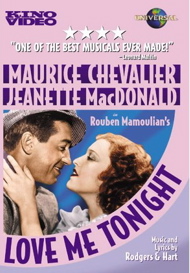
Love Me Tonight
1932 / 89 min.
Starring Maurice Chevalier, Jeanette MacDonald, Charles Ruggles, Charles Butterworth, Myrna Loy
Cinematography Victor Milner
Original Music & Lyrics by Richard Rodgers & Lorenz Hart
Written by Samuel Hoffenstein, George Marion Jr., Waldemar Young from a play by Paul Armont, Léopold Marchand
Produced and Directed by Rouben Mamoulian
Hailed with good reason as the best original film musical of all time, Love Me Tonight is nothing less than astonishing in its inventiveness. Rouben Mamoulian made his share of great pictures but his technical and cinematic advances were never fully acknowledged. 1929's Applause enticed the talkie camera out of the glass booth and forged workarounds to overcome the limited ability of audio engineers to mix tracks. In this film Mamoulian brings the entire vocabulary of filmic possibilities forward to unchain the movie musical from its "stand there and sing" limitations. Combine that with wonderful Rodgers and Hart songs and a Pre-Code script packed with suggestive wit, and Love Me Tonight is still a liberating experience.
In this one feature Rouben Mamoulian (Dr. Jekyll & Mr. Hyde, Blood and Sand) almost single-handedly invents the vocabulary of filmic musical possibilities. He opens the picture with a musical montage that assembles random city noises (a worker's pick, a cobbler's hammer) into an introduction for the first song. The music score mirrors every motion of the players as they run through city streets, ride on horses or ascend stairs in the mansion -- the 'pictures 'n' music' chemistry is always ready for a song to commence. Actor's speeches first slide into subtle rhymes, which then take on a rhythm that makes Chevalier's bursting into full song completely natural.
The second full song is the standard Isn't It Romantic? It begins with sarcastic lyrics sung by the low-born Maurice before a three-paneled folding mirror. A fast montage takes hold as a songwriter (Tyler Brooke) overhears the tune and carries it with him into a taxi. He writes more lyrics as he waits for a train with a group of soldiers. Then the soldiers adopt it for a marching song, and a Gypsy boy brings it back to his campfire where it becomes a romantic violin piece. Hearing this from her balcony, the Princess Jeanette sings the formal lyrics in a full Operetta style. Thus Isn't It Romantic? has established a link between two people separated by distance and class boundaries. They've never met one another, but Maurice and Jeanette are clearly made for each other.
Other musical numbers -- often difficult to distinguish from the 'non-musical' sections of the movie -- plumb most of the possibilities of filmed performance that will be used for the next 75 years. The tune The Son of a Gun is Nothing But a Tailor rounds up the entire chateau staff to condemn our hero, all contributing a line or two while doing their jobs in different parts of the house. In another song, the dog pipes up with a note (in the right key!) and even a bas-relief on the wall chimes in with a lyric. Yet another tune plays out over an image of Maurice sleeping in his bed. An image of the sleeping Jeanette dissolves in next to him, forming a literal pre-echo of a visual motif in 1959's Pillow Talk. Another oddball musical idea has stuffy old C. Aubrey Smith bursting out in a romantic song as he wakes in the morning, and the effect is hilarious ... we just aren't used to seeing Smith this animated.
We're surprised when a zoom lens is used to zero in on a smokestack in the first scene, and even more intrigued to see a mounted hunting party 'leave quietly' by galloping away in slow motion. Almost every scene introduces something new.
The comic story sticks close to the topics of romantic pursuit and sexual attraction. Spicy and suggestive situations, dialogue and lyrics abound: A shop-keeper's wife laments that she wants a beau, and when asked about her husband says, "He could use the dough." Charles Ruggles' rascally Viscount uses a footrace as camouflage when he's forced to flee from a woman's room in his underwear. When Jeanette faints, the minx-ish Myrna Loy is asked if she could go for a doctor. "Could I?" she answers, "Bring him in!" We're told that Loy originally had a running gag in which she invites various males to "Come see the Virgin's Spring."
As for Jeanette MacDonald and glamour, she's not without appeal. The movie contrives several times to place MacDonald in a slip and a nightgown, and even has tailor Chevalier take her bust measurement, which must have been a provocative moment in 1932. Suffice to say that she's much more sensual and less saccharine than in her (not objectionable) later operettas for MGM.
After the usual misunderstandings and romantic appeals, Maurice leaves the chateau in disgrace. But the previously faint-of-heart Jeanette storms across the countryside on horseback and defies a locomotive to prevent her lover from fleeing back to Paris, even if he is nothing but a tailor. Love Me Tonight ends with love conquering all, and the rest of us realizing that everything 'initiated' by MTV in the 1980s had been pioneered fifty years before.
Kino's DVD of Love Me Tonight retains a Universal logo, perhaps acknowledging the source of the superior transfer. The sharp picture has only a few flaws and scratches, and the sound is good. The only drawback with Kino's disc is that Universal or Paramount would probably include optional English subtitles, insuring that we catch every risqué dialogue line.
Miles Kreuger's commentary benefits from his association with the late director Mamoulian. He points out scores of notable innovations in Love Me Tonight that the casual viewer might miss.
We also get a pair of 'newsreel' song performances by Maurice Chevalier and Jeanette MacDonald and an original trailer that acknowledges that the two are already a potent romantic team (The Love Parade, One Hour with You). A gallery of stills and ad art include, along with production records, censorship memos and screenplay excerpts of deleted scenes. The chances are that when Paramount sold its library to MCA in the late 1950s, the original Pre-Code version and these deleted scenes were destroyed forever.
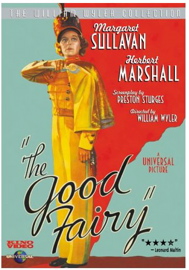
The Good Fairy
1935 / 98 min.
Starring Margaret Sullavan, Herbert Marshall, Frank Morgan, Reginald Owen, Eric Blore
Cinematography Norbert Brodine
Art Direction Charles D. Hall
Film Editor Daniel Mandell
Written by Preston Sturges from a play by Ferenc Molnár
Produced by Carl Laemmle Jr.
Directed by William Wyler
This utterly charming picture stems from the fertile mind of Hungarian playwright Ferenc Molnár. His most famous play Lilliom has been filmed several times successfully and adapted into the Rodgers and Hammerstein musical Carousel. Billy Wilder adapted a Molnár play to make his hit One, Two, Three. This 1935 screen adaptation is an early writing credit for Preston Sturges. The estimable William Wyler directed; star Margaret Sullavan was married to him during filming. Like its fairy-tale title, the entire film radiates a simplicity and warmth, even though its subject matter is the possible ruin of a naíve and innocent orphan at the hands of several sophisticated men.
For most of its running time The Good Fairy hangs on the slender thread of its sweet premise. The bright eyed and unassuming Lu thinks the best of people and barely understands what all these men want of her -- but she recognizes a pickup artist (Cesar Romero) when he bothers her at the theater door. Lu attends a fancy dance like a Cinderella. Preston Sturges' adaptation has plenty of his touches, in the way the orphanage director (Beulah Bondi) resigns herself to receiving a visitor, and when the theater owner (Alan Hale) and a chubby orphan stick out their tongues at each other. Although the slapstick is kept in check, Eric Blore has a funny bit as a perpetually plastered government minister who can barely make it up and down a short flight of stairs.
As soon as Herbert Marshall and Margaret Sullavan share the screen, we know that they will eventually live happily ever after. She cannot help but make fun of his fussy little beard and we know he's smitten when he's willing to shave it off. Marshall works hard to match Sullavan's utter sweetness. Frank Morgan carries most of the film's conflict and his manner can be a little grating. Trying to play parlour games with Lu, his Konrad asks her at one point to imagine that he's a Wizard who can bestow wonderful gifts. He also says the word "MAH-ve-lous!" about ten times too often. Reginald Owen clowns nicely as the paternalistic waiter.
Purists will point out that this Sturges/Wyler confection isn't quite as light on its feet as Lubitsch, but that's no crime. This is really a 'dirty fairy tale' in the tradition of Trouble in Paradise, The Miracle of Morgan's Creek and The Apartment: A story of a girl's virtue in danger of being compromised. Margaret Sullavan is certainly better than most in playing the earnest, open-faced innocent. Wyler keeps the direction simple. Lu and Max's drive in his new car is played completely in a single process shot. Cameraman Norbert Brodine contributes one rather amazing impossible double mirror shot, the kind that shows multiple images of Sullavan stretching to infinity. But why can't we see the camera? Look carefully for a little black square in the background, visible only for a few frames.
The Good Fairy was originally a Universal release and the packaging still holds their copyright, so perhaps this disc is a result of some licensing deal. The transfer is excellent, as good for quality as any vintage Universal product. An antiquated trailer is included, along with some family stills from William Wyler's personal collection.
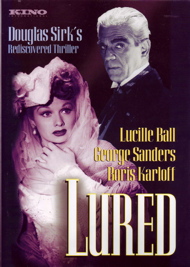
Lured
1947 / 102 min. / Personal Column
Starring George Sanders, Lucille Ball, Charles Coburn, Boris Karloff, Cedric Hardwicke
Cinematography William Daniels
Production Design Nicolai Remisoff
Film Editor John M. Foley, James E. Newcom
Original Music Michel Michelet
Written by Leo Rosten story by Jacques Companéez, Simon Gantillon, Ernest Neuville
Produced by James Nasser, Hunt Stromberg
Directed by Douglas Sirk
Made at a time when German emigré director Douglas Sirk and star Lucille Ball were trying their hand at mysteries and noirish subject matter, Lured comes off as an odd but un-special thriller about a showgirl trying her hand as a police spy. Although the script takes some awkward story turns the cast is a treat. Ms. Ball looks good walking on rain-swept city streets (The Dark Corner) and only top-billed George Sanders seems out of place as the main suspect.
Lured fulfills the requirements of Kino's boxed set by delivering Lucille Ball, the famous Technicolor beauty of several MGM musicals. Ball surmounted a decade of walk-ons and glamour bits but never quite clicked as a first-rank feature star. Even when limited by B&W she's equally adept at comedy, light romance and serious drama. Around this time Ball was playing comedy support to actors like Bob Hope and William Holden, but for Lured she holds center stage amid a screen-ful of great character actors, all of them adept scene stealers
Some of the actors shine in refreshingly different roles. Stereotyped villain George Zucco is charming as Sandra's kindly police watchdog, and Boris Karloff is interesting as a mostly harmless madman. His isolated sequence has a truly strange tone, as we cannot decide if he's a true threat or merely eccentric. Sandra thinks she's going to model for a painting, but Karloff instead dresses her up for a bizarre charade with an audience made up of manikins and household pets.
When that episode is finished the story lurches between the search for the killer, Sandra's blossoming romance with George Sanders and a completely unrelated smuggling subplot. The dialogue is often smart, some of the incidents are interesting and Lucille Ball's romantic predicament develops nicely. But the movie never builds much tension. When suspicion points to Sanders, we can too easily guess the identity of the killer. The mystery's conclusion is logical, but not very exciting.
Cedric Hardwicke is Robert Fleming's deceptively meek best friend while Joseph Calleia and Alan Mowbray are excellent as a scurvy pair of criminals. Charles Coburn is a paternal top cop. George Sanders' character begins as a cynical playboy, chatting up Sandra on the phone while holding his present date in his arms. That's a perfect fit for Sanders' personality, but when the script demands that he be nobly indignant and then devoted to the confused Sandra, something doesn't click. Douglas Sirk's direction helps Lucille Ball stay on top of a number of moods. She's ecstatic when her Scotland Yard expense account allows her to buy fancy evening clothes, cautiously skittish while playing Boris Karloff's creepy games and loyal to Robert Fleming even when all the evidence is against him.
The United Artists release creates an atmospheric studio London with William Daniels' handsome photography, and Hunt Stromberg's production doesn't skimp on the trimmings. With a slightly more focused screenplay, this could have been a minor classic.
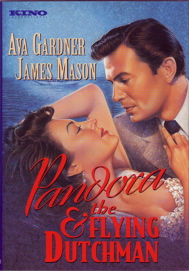
Pandora and the Flying Dutchman
1951 / 122 min.
Starring James Mason, Ava Gardner, Nigel Patrick, Sheila Sim, Harold Warrender
Cinematography Jack Cardiff
Production design John Bryan
Film Editor Ralph Kemplen
Original Music Alan Rawsthorne
Produced by Joe Kaufmann, Albert Lewin
Written and Directed by Albert Lewin
Viewers looking for romantic fantasy may be swept away by Pandora and the Flying Dutchman, Albert Lewin's ode to the respective beauties of Ava Gardner and James Mason. Lewin's classy films aimed higher than David O. Selznick's 'literature to the masses' pictures of the 1930s, and he touched on delicate politics (So Ends Our Night) and continental subjects, as in Zaza. Lewin's artsy pictures The Moon and Sixpence, The Picture of Dorian Gray and The Private Affairs of Bel Ami include mature themes discouraged by the Production Code. Critics tended to either think Lewin the most cultured producer in Hollywood, or demeaned his efforts as kitsch, or as vehicles for the sardonic personality of George Sanders.
Pandora and the Flying Dutchman may be Lewin's most lavish film, produced in Spain and England and filmed in Technicolor by Jack Cardiff. Although it tends to drag with the weight of unnecessary dialogue, it's a pleasure to watch: Mason and Gardner have the fantastic good looks needed to sustain a tale of delirious love.
Some romantic fantasies don't have what it takes to charm an audience and others are based on flawed concepts. David O. Selznick poured a couple of years and millions of dollars into a beautiful movie called Portrait of Jennie and then almost buried its appealing central concept in a fussily overblown production. With Pandora and the Flying Dutchman Albert Lewin has everything going for him, including an extremely hot romantic pair ... James Mason was at the height of his brooding appeal, and Ava Gardner is almost too luscious to be real.
But Lewin lets his endlessly talky script get out of control. Harold Warrender plays a sage philosopher type with a pungent nugget of wisdom for every occasion (para): "To understand a single human heart is like emptying the ocean with a spoon." The story, the photography and the fire in the lovers' eyes tell us all we need to know, but somebody is forever translating the subtext into preachments, and making the obvious more obvious. The show is just over two hours long and could easily have fifteen minutes knocked out of it. The strength of a fascinating show like The Moon and Sixpence was Lewin's deft adaptation of another author's work. This screen original runs off at the mouth.
There are plenty of compensations, with Jack Cardiff's photography right up top. Naturally, the close-ups of the stars are to die for. Cardiff's images craning over sunny Spanish rooftops put the scenery into our laps. The opening shot peering through a clanging bell at a death scene on the beach is a real achievement for the Technicolor camera.
In the middle of Pandora and the Flying Dutchman is an extended flashback to a 17th century Spanish court, and clever art direction combined with Cardiff's work make it a visual highlight. The emphasis is on huge rooms with tiled floors, often with stark checkerboard patterns; with the period costumes and dressings it looks as if Hendrik van der Zee's back story is taking place in a different dimension. The subtle surreal effect combines well with James Mason's despairing, rage-filled speeches, when he defies God and the Cosmos to punish him without mercy.
Although most of the modern set pieces have an equal appeal (Pandora and the Flying Dutchman is still better-directed than Joseph L. Mankiewicz's The Barefoot Contessa, for a couple of scenes Lewin's taste turns to kitschy goo. One 'decadent' beach party scene shows the proto- jet setters dancing amid Grecian columns and marble statues, all posed to imitate bad surreal imagery. A scene like that can make one suspicious of the entire enterprise. Lewin may have just been trying too hard to create "art": For his unit still photographer he hired Man Ray.
Pandora and the Flying Dutchman is overlong. Its narrative is just fuzzy enough not to leave a sharp impression; I've seen the picture several times and can never remember exactly what happens. It was an MGM release and a Romulus production and somehow its rights became unhinged. It appears to have fallen into the collection of Raymond Rohauer. All video transfers have been made from Technicolor prints and not fared well. Printing or telecine elements want to have low contrast, and the high contrast of a Tech print results in blacks 'clogging up' -- where the print might have ten levels of dark gray to black, the transfer just sees black. Colors also tend to be distorted.
Kino put out a VHS version that I can't recommend at all, but this 2000 DVD looks much better. Except for a fall-off of detail in the darker parts of the frame, the image is a reasonable facsimile of the collector print I saw of the picture at UCLA in 1974 or so. The disc also comes with a trailer.
On a scale of Excellent, Good, Fair, and Poor,
|
The Blue Angel rates:
Movie: Excellent Video: Good Sound: Good Supplements: none |
Love Me Tonight rates:
Movie: Excellent Video: Very Good Sound: Very Good Supplements: Commentary by Miles Kreuger, extra songs, trailer, stills, production papers, censorship notes, script pages of deleted scenes |
|
The Good Fairy rates:
Movie: Excellent Video: Very Good Sound: Very Good Supplements: Trailer, William Wyler photos |
Lured rates:
Movie: Good Video: Very Good Sound: Very Good Supplements: none |
|
Pandora and the Flying Dutchman rates:
Movie: Very Good Video: Good Sound: Good Supplements: Trailer |
Packaging: five slim cases in card sleeve Reviewed: November 30, 2006 |
Review Staff | About DVD Talk | Newsletter Subscribe | Join DVD Talk Forum
Copyright © MH Sub I, LLC dba Internet Brands. | Privacy Policy | Terms of Use
|
| Release List | Reviews | Price Search | Shop | SUBSCRIBE | Forum | DVD Giveaways | Blu-Ray/ HD DVD | Advertise |





